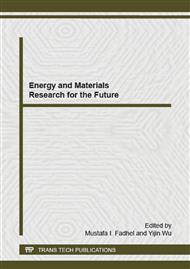p.18
p.22
p.26
p.31
p.38
p.43
p.50
p.55
p.63
The Influence of Crystallization on the Ionic Conductivity of PEO/LiClO4 Polymer Electrolytes
Abstract:
It’s generally accepted that the transport of lithium ions in solid polymer electrolytes exists mainly in the amorphous regions, thus the research has focused on reducing the crystallinity to obtain high conductivity at room temperature. However, the point has been challenged: crystalline systems can provide a better ionic conductivity. In this paper, PEO/LiClO4 polymer electrolytes with different lithium-oxygen ratios were prepared by melt-blending. The results show that [EO]/ [Li+] = 3 system has higher ionic conductivity, 4.26×10-6 S/cm, more than twice as that of [EO]/ [Li+] = 4 system. DSC and XRD results show PEO3:LiClO4 crystalline phase present in both systems, the crystallinity of [EO]/ [Li+] = 3 system is higher. It illustrates the generally accepted mechanism is not suitable for these systems, suggesting the high conductivity of [EO]/ [Li+] = 3 system is due to the unique crystal structure of PEO3:LiClO4. Besides, as the crystallinity increases, the tensile strength of [EO]/ [Li+] = 3 system increases greatly, to 1.43 MPa. In addition, because of the high melt temperature of PEO3:LiClO4, the electrolytes will gain excellent heat resistance. In summary, this paper provides a new idea to prepare polymer electrolytes with high ionic conductivity, improved strength and excellent heat resistance in large scale.
Info:
Periodical:
Pages:
38-42
Citation:
Online since:
February 2015
Authors:
Price:
Сopyright:
© 2015 Trans Tech Publications Ltd. All Rights Reserved
Share:
Citation:


